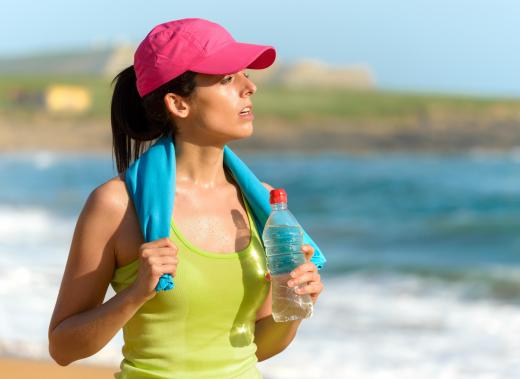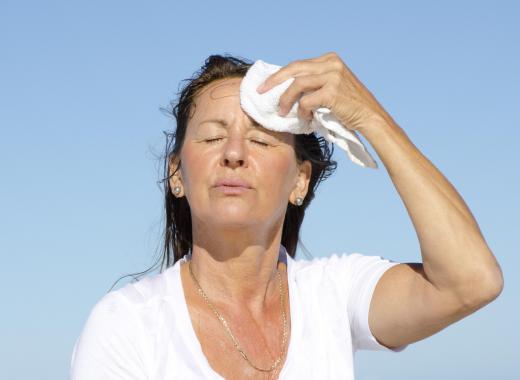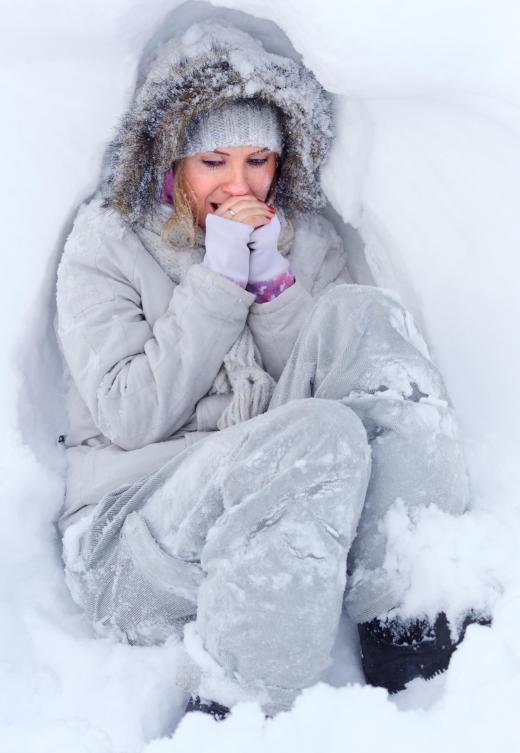What Determines the Feels Like Temperature?
 Nicole Madison
Nicole Madison
Often, simply learning the expected high and low temperatures isn’t adequate preparation for going outdoors. Many people wait to hear the feels like temperature before they plan what to wear and where to go on any given day. This temperature gives people an idea about how they will feel outdoors, rather than a simple temperature that leaves them guessing. To determine this temperature, meteorologists must take into account factors like the wind chill and the heat index.
The feels like temperature is often determined in part by the wind chill during the winter months. Wind chill involves measuring the temperature as it is felt on the skin, which is determined by the air temperature and wind speed. In other words, it's a measure of the heat skin loses when the wind blows on it. The wind chill is typically always lower than the temperature of the air because wind increases how quickly moisture evaporates from the skin and serves to move heat away from the body. At higher temperatures, wind chill is considered far less significant and is usually not reported.

The heat index takes into account both the air temperature and the humidity in determining how warm temperatures feel to a person outdoors. When an individual perspires, the water in his or her sweat evaporates. This helps cool the body because heat is carried away during evaporation. When humidity is high, sweat cannot evaporate as easily, so people have a harder time cooling off, resulting in a higher heat index.

People should keep in mind that the feels like temperature they hear when listening to a local weather forecast may not be enough to determine how each individual will feel in certain weather. For example, heat index measurements are given for shady conditions with light wind evident. In full sunshine, the temperature may seem hotter than the heat index indicates. By the same token, if someone is standing in a sheltered area that receives full sun in winter, he or she may feel a bit warmer than the estimated wind chill.

The feels like temperature is particularly important for health reasons. When the heat index is very high, people may be at increased risk for heat exhaustion and heat stroke. Likewise, extreme wind chill temperatures can put people at risk for frostbite and hypothermia. As such, it is important for people to pay attention to these numbers in addition to the actual forecast temperature for the day.
AS FEATURED ON:
AS FEATURED ON:















Discussion Comments
Anon25157. "Does 'feels like' temperature only apply to 'humans' and 'skin'? Does it affect water freezing?"
That is what I was wondering. With wind chill and dew point /wind chill/Real Feel was -18C this morning. Temperature says -13C so for the car starting or having trouble starting is it only -13C.
"Feels like" is meaningless, misleading and potentially dangerous.
I find this "feels like" temperature confusing because there are differences among people. A young person will be less cold than an old man, for example, and someone healthy will be also less affected by the low temperatures than someone with a cold. If you say simply it is 10 *C or *F, you know what the temperature is.
I suppose people aren't understanding heat index or the "feels like temperature" because no one has taken the time to quantify what it means. To do this, we'll take relative humidity as humidity and take temperatures in degrees Fahrenheit and pit high humidity (saturated) versus low humidity (dry). For both of these, no wind.
In Miami, Florida with a 90 degree F temperature and humidity of 85 percent, this effectively equals a (very humid, sticky) heat index of 117 degrees F. You'll sweat in Miami and you'll continue to sweat. You'll be drenched. The sweat sticking to you and the sweat sticking to your clothes won't evaporate in south Florida. You can keep rehydrating and you'll keep sweating and the sweat will continue to cling to your clothes until you're literally drenched, but the sweat doesn't evaporate; it just keeps adding to the already existing sweat. It's brutal, deceptively brutal in Miami. If you want to test this come to central or south Florida in the middle of summer -- either Orlando, Florida, Tampa, Florida or Miami, Florida in July will suffice -- try any of the above destinations in July. So despite all warnings not to, you schedule a vacation for Florida in July or August for two weeks and that's all it will take -- you'll never come back to the state of Florida in the middle of summer ever again.
Now take 90 degrees F in a relatively drier climate in the US in which the humidity is 10 percent, you'll find that the heat index or the real feel temperature only comes to 85F.
So, 90F in Phoenix, Arizona with 10 percent humidity means it's dry --- 90F with 10 percent humidity actually feels like 85F and dry. You sweat, it evaporates, no sweat actually sticks to your clothes and it's more like a warm oven when you step outdoors, but it's not that bad.
Miami, FL: 90F, 85 percent humidity = heat index = 117F (humid, sweat it out, seek air conditioned places) = feels like Thailand.
Phoenix, AZ: 90F, 10 percent humidity = heat index = 85F (dry, you sweat and the sweat evaporates and the real feel temp = 85F is actually lower than the actual air temp = 90F)
This is not to say that high temperatures in extremely dry climates are not as severe. Actually, with Las Vegas, Nevada or Death Valley, California, as examples, a dry 110F with 10 percent humidity equals 104F. There's no humidity to inflate the "feels like temperature" and actually the low humidity drops the heat index or real feel to 104F. 110F, even with the noted heat index of 104F at 10 percent humidity, is still a very high temperature that will kill you. That's how Death Valley got its name. You'll dehydrate in 110F easily, but it'll only feel like 104F. I know, big difference, right? You just won't feel the sweat sticking to you in the desert because as fast as you sweat, the sweat evaporates just as quickly and you stay dry.
With hot, humid subtropical/tropical climates, high humidity is a factor due to proximity to water and high humidity works almost as a multiplier with the temperature to create a higher heat index or a higher real feel temp than the actual air temperature. Without any wind, the humidity lingers -- step off a plane in Miami, Florida in the spring or summer departing from Chicago, Illinois and Miami will greet you with a punch in the face. Not literal, but you're going to feel the heat and humidity in Miami because it's like a strong wall of air that hits you immediately and it almost suffocates. The same goes for any state in the southeast close to the Gulf of Mexico in summer. Summers in the Southeast are unkind and it's the high humidity that accentuates that miserable unpleasantness.
In places like Hawaii or Guam – islands -- with a gentle wind or trade winds, the humidity will be high, but at least on windy days, the winds help to offset the humidity or move the air around so that the sweat doesn't stick to you as much. With no wind, Hawaii and Guam will have that high heat, high humidity factor and the sweat will stick to you and then it's not comfortable.
Because I brought up Thailand, the current temperature in late March in Bangkok, Thailand at 5 a.m. is 84F, with humidity = 84 percent, and a heat index = 96F. If the forecast calls for a clear, sunny day with a high temperature of 96F, humidity = 45 percent, it will feel like 106F for the heat index.
Actually, the National Weather Service and NOAA website explains all of this.
@anon260194: I don't think the residents of Central Florida would agree with you about their humidity. The only thing that helps keep it in check is the breeze you get either from the Atlantic, or the Gulf of Mexico, depending on which way the wind is blowing. If it's coming in from the north or south, or there isn't much breeze at all, it is beyond miserable.
I live in North Alabama, and when, as we say, the Gulf is "open for business," we get plumes of moisture that just sit over us. When it's 95 degrees outside and the humidity is 90 percent, it's like trying to swim in the air, and you'll run out of energy just walking to the mailbox! We call that the heat index, and any meteorologist will tell you that humidity is just as brutal as dry heat.
Extreme dry heat is deceptive. You'll dehydrate before you realize you're that hot. In humid weather, you sweat it all out, and then dehydrate. Neither is pleasant.
Also, a warning to pet owners: please do *not* leave your unattended pet in a car that doesn't feel "that hot" to you. I can assure you if the temperature is 60 degrees outside, it's going to be about 10 or more degrees hotter in the car. Then add another 10 degrees to that because pets body temps run hotter than ours.
Also remember if you leave your dog 'in the shade' that the sun will move, things will heat up and in under an hour, a car can feel like an oven.
I see a lot of people leaving dogs in their cars with windows barely down, or not down at all, because they think it's cloudy outside and so the dog isn't feeling the heat. Wrong. Between the dog's naturally high body temps and the inside of the car heating up, an hour in a locked car can be fatal to a dog.
I don't know how many times I see owners leave their dogs in cars and regardless if windows are down, if it isn't actually cold and overcast outside, or you can't park in a cool parking structure that won't heat up, leave your dogs at home!
@anon111714: I also feel the same. In California, it's dry, hot and when it does get humid there (closer to bodies of water), it can be the kind that drains any energy you have, unlike, say, Central Florida, where it's humid and hot but the humidity seems to be in balance. Your skin breathes better and the temperatures, even if high, don't do the same things to the body that it would do in Southern California.
Also, in the Pacific Northwest where temps tend to be cooler overall, the spring and summer can be unbearably warm even with some clouds in the sky. The weather report will say 68 degrees but it feels like 80 and your skin can feel like it's searing.
@Anon111714: To answer your question: because the water particle (humidity) in the air blocks the heat evaporated from your body, and that's why you feel hot.
Additionally, in the high humidity environment, the ESD (electrostatic)is low, due to the water particles in the air takes away those ESD from your skin surface. However, in a low humidity condition, ESD is always high. From, China Luoyang.
OK, so let's say the air temperature is 33 degrees and the wind is blowing 30 mph. Does this mean that water won't freeze because the air temperature is above 32, even though the wind chill is well below 32 experientially?
The amount of water the air can hold is determined by the air temperature, correct? Or does the wind speed play a part? Or does it really matter at all because what temperature is perceived -- by human or glass of water, is for all intents and purposes, the temperature?
How come they say humidity makes it feel hotter? Does this only work in some people because I don't mind the 85 in Oklahoma with humidity but in So. California, 85 is way too hot! I can't tolerate the dryness. I feel like I can't breathe and my throat dries up and cracks and I feel like I'm going to faint without the humidity. I can take a long walk in OK, but not in So California. I don't understand.
Oh, good anon59286 so you did read my post all the way through and agree with me that the aid from wind removes heat faster from water.
subguy752: The way I see it is the wind only removes heat units faster, does not matter if it is from open water or skimmed over frozen water or water in a jar. You are losing heat units till the water stabilizes with its surrounding environment. Lets don't consider the cooling effect of evaporation. Basic physical properties.
Number 1, wind chill only applies to warm blooded critters.
No matter what the temperature feels like to you because of the wind speed the true temperature will be measured in the surrounding area and objects. Now water, being denser than air, will take longer to release its heat and stabilize. So I think the wind would play a role initially when the water was slowly giving off its heat, but once a few inches of ice was built up it would not make any difference.
Does 'feels like' temperature only apply to 'humans' and 'skin'? Does it affect water freezing?
Post your comments